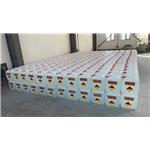Colorless to pale yellow liquid. May explode if exposed to heat , shock, or friction. Material must be stored and transported in temperature controlled container. Insoluble in water.
Peroxides, such as Tert-Amyl peroxyneodecanoate, are good oxidizing agents. Organic compounds can ignite on contact with concentrated peroxides. Strongly reduced material such as sulfides, nitrides, and hydrides may react explosively with peroxides. There are few chemical classes that do not at least produce heat when mixed with peroxides. Many produce explosions or generate gases (toxic and nontoxic). Generally, dilute solutions of peroxides (<70%) are safe, but the presence of a catalyst (often a transition metal such as cobalt, iron, manganese, nickel, or vanadium) as an impurity may even then cause rapid decomposition, a buildup of heat, and even an explosion. Solutions of peroxides often become explosive when evaporated to dryness or near-dryness. May explode from heat or contamination. May explode from heat, contamination or loss of temperature control. These materials are particularly sensitive to temperature rises.

